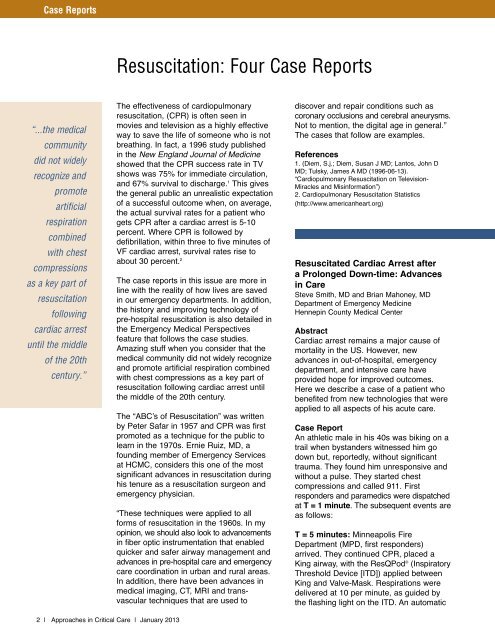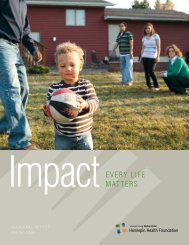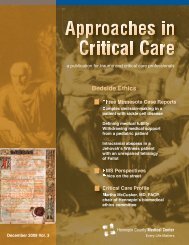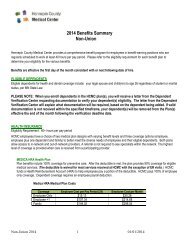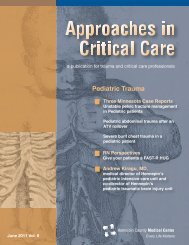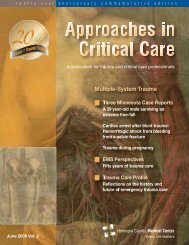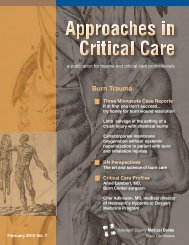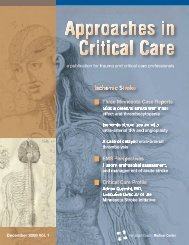HCMC_P_049062 - Hennepin County Medical Center
HCMC_P_049062 - Hennepin County Medical Center
HCMC_P_049062 - Hennepin County Medical Center
You also want an ePaper? Increase the reach of your titles
YUMPU automatically turns print PDFs into web optimized ePapers that Google loves.
Case Reports<br />
Resuscitation: Four Case Reports<br />
“...the medical<br />
community<br />
did not widely<br />
recognize and<br />
promote<br />
artificial<br />
respiration<br />
combined<br />
with chest<br />
compressions<br />
as a key part of<br />
resuscitation<br />
following<br />
cardiac arrest<br />
until the middle<br />
of the 20th<br />
century.”<br />
The effectiveness of cardiopulmonary<br />
resuscitation, (CPR) is often seen in<br />
movies and television as a highly effective<br />
way to save the life of someone who is not<br />
breathing. In fact, a 1996 study published<br />
in the New England Journal of Medicine<br />
showed that the CPR success rate in TV<br />
shows was 75% for immediate circulation,<br />
and 67% survival to discharge. 1 This gives<br />
the general public an unrealistic expectation<br />
of a successful outcome when, on average,<br />
the actual survival rates for a patient who<br />
gets CPR after a cardiac arrest is 5-10<br />
percent. Where CPR is followed by<br />
defibrillation, within three to five minutes of<br />
VF cardiac arrest, survival rates rise to<br />
about 30 percent. 2<br />
The case reports in this issue are more in<br />
line with the reality of how lives are saved<br />
in our emergency departments. In addition,<br />
the history and improving technology of<br />
pre-hospital resuscitation is also detailed in<br />
the Emergency <strong>Medical</strong> Perspectives<br />
feature that follows the case studies.<br />
Amazing stuff when you consider that the<br />
medical community did not widely recognize<br />
and promote artificial respiration combined<br />
with chest compressions as a key part of<br />
resuscitation following cardiac arrest until<br />
the middle of the 20th century.<br />
The “ABC’s of Resuscitation” was written<br />
by Peter Safar in 1957 and CPR was first<br />
promoted as a technique for the public to<br />
learn in the 1970s. Ernie Ruiz, MD, a<br />
founding member of Emergency Services<br />
at <strong>HCMC</strong>, considers this one of the most<br />
significant advances in resuscitation during<br />
his tenure as a resuscitation surgeon and<br />
emergency physician.<br />
“These techniques were applied to all<br />
forms of resuscitation in the 1960s. In my<br />
opinion, we should also look to advancements<br />
in fiber optic instrumentation that enabled<br />
quicker and safer airway management and<br />
advances in pre-hospital care and emergency<br />
care coordination in urban and rural areas.<br />
In addition, there have been advances in<br />
medical imaging, CT, MRI and transvascular<br />
techniques that are used to<br />
discover and repair conditions such as<br />
coronary occlusions and cerebral aneurysms.<br />
Not to mention, the digital age in general.”<br />
The cases that follow are examples.<br />
References<br />
1. (Diem, S.j.; Diem, Susan J MD; Lantos, John D<br />
MD; Tulsky, James A MD (1996-06-13).<br />
“Cardiopulmonary Resuscitation on Television-<br />
Miracles and Misinformation”)<br />
2. Cardiopulmonary Resuscitation Statistics<br />
(http://www.americanheart.org)<br />
Resuscitated Cardiac Arrest after<br />
a Prolonged Down-time: Advances<br />
in Care<br />
Steve Smith, MD and Brian Mahoney, MD<br />
Department of Emergency Medicine<br />
<strong>Hennepin</strong> <strong>County</strong> <strong>Medical</strong> <strong>Center</strong> <br />
Abstract<br />
Cardiac arrest remains a major cause of<br />
mortality in the US. However, new<br />
advances in out-of-hospital, emergency<br />
department, and intensive care have<br />
provided hope for improved outcomes.<br />
Here we describe a case of a patient who<br />
benefited from new technologies that were<br />
applied to all aspects of his acute care.<br />
Case Report <br />
An athletic male in his 40s was biking on a<br />
trail when bystanders witnessed him go<br />
down but, reportedly, without significant<br />
trauma. They found him unresponsive and<br />
without a pulse. They started chest<br />
compressions and called 911. First<br />
responders and paramedics were dispatched<br />
at T = 1 minute. The subsequent events are<br />
as follows:<br />
T = 5 minutes: Minneapolis Fire<br />
Department (MPD, first responders)<br />
arrived. They continued CPR, placed a<br />
King airway, with the ResQPod ® (Inspiratory<br />
Threshold Device [ITD]) applied between<br />
King and Valve-Mask. Respirations were<br />
delivered at 10 per minute, as guided by<br />
the flashing light on the ITD. An automatic<br />
2 | Approaches in Critical Care | January 2013


